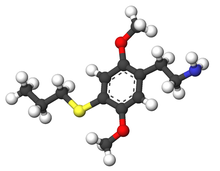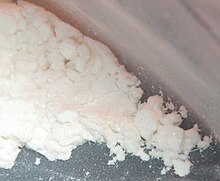2C-T-7 is a psychedelic phenethylamine of the 2C family. In his book PiHKAL: A Chemical Love Story, Alexander Shulgin lists the dosage range as 10–30 mg. 2C-T-7 is generally taken orally, and produces psychedelic and entactogenic effects that last 8 to 15 hours.[1] Up until Operation Web Tryp and three deaths, two of which involved the use of other drugs in addition to 2C-T-7, and one which involved an excessive insufflated dose, 2C-T-7 was sold commercially in Dutch and Japanese smartshops and online. It is known on the streets as Blue Mystic or 7th Heaven.[2][3] There has been little real research done on this chemical other than Shulgin's comments in PiHKAL and a few small animal studies mostly aimed at detecting metabolites.

| |

| |

| |
| Names | |
|---|---|
| Preferred IUPAC name
2-[2,5-Dimethoxy-4-(propylsulfanyl)phenyl]ethan-1-amine | |
| Other names
2,5-Dimethoxy-4-(propylsulfanyl)phenethylamine, 2,5-Dimethoxy-4-(propylthio)phenethylamine, Blue Mystic, Tweety-Bird Mescaline
| |
| Identifiers | |
3D model (JSmol)
|
|
| ChEMBL | |
| ChemSpider | |
| KEGG | |
PubChem CID
|
|
| UNII | |
CompTox Dashboard (EPA)
|
|
| |
| |
| Properties | |
| C13H21NO2S | |
| Molar mass | 255.38 g/mol |
| Melting point | 206 to 207 °C (403 to 405 °F; 479 to 480 K) |
| Pharmacology | |
| Legal status |
|
Except where otherwise noted, data are given for materials in their standard state (at 25 °C [77 °F], 100 kPa).
| |
Pharmacology
editThe mechanism that produces the psychedelic and entactogenic effects of 2C-T-7 is most likely to result from action as a 5-HT2A serotonin receptor agonist in the brain, a mechanism of action shared by most currently-known hallucinogenic tryptamines and phenethylamines.[4] 2C-T-7 has structural and pharmacodynamic properties similar to those of 2C-T-2.
Effects
edit2C-T-7 is psychedelic.[5][6] In PiHKAL, Shulgin records that the hallucinations are unique, and that the chemical may cause muscle tension and an altered vocal quality.[7] Shulgin rated it as one of the "magical half-dozen" most important psychedelic phenethylamine compounds, together with Mescaline, 2C-B and 2C-T-2.[8]
Deaths
editThere have been at least three reported deaths related to 2C-T-7 use as of August 2007, mainly at insufflated (snorted) doses of 30 mg or more.[9][10] In the fall of 2000, a young healthy male died following insufflation of an excessive amount of 2C-T-7. Two additional deaths reported in April 2001 have been linked to 2C-T-7. These two deaths were reported by the DEA as being the result of the co-abuse of 2C-T-7 with MDMA.[11]
In January 2002, Rolling Stone published an article about 2C-T-7 entitled "The New (legal) Killer Drug".[12] Although the article suggested that the drug was legal, the legal status of 2C-T-7 was ambiguous at the time due to the United States' Federal Analogue Act. [13] A detailed response on the website disinfo.com challenged the accuracy of much of the reporting in the aforementioned Rolling Stone article.[14] 2C-T-7 has since been officially made illegal and declared a schedule 1 substance in the United States.[15]
The Partnership for a Drug-Free America reported in 2006 that 2C-T-7 can be lethal even in small doses;[16] however, they provide no source for their claim and of the three known deaths (as of August 2007) of 2C-T-7 intoxicated individuals, all involved either uncommonly large insufflated doses or the concomitant ingestion of other stimulants such as ephedrine and/or MDMA.
All of the three aforementioned known deaths of individuals under the influence of 2C-T-7 occurred in those known to be either intoxicated with other stimulants such as ephedrine or MDMA (which are known to be potentially lethal in certain situations or at excessive doses)[17] or after the individual insufflated an amount of 2C-T-7 much greater than necessary to induce the full range of effects typically sought after by users of the drug; for example, the reported 35 mg insufflated dose taken by the individual who died in the fall of 2000. This reported dose was characterized as "excessive" by the US DEA.
Legal status
editAround the year 2000, 2C-T-7 began to change from an obscure chemical to a drug used at parties and clubs in North America and Europe as it became available through a number of grey-market commercial vendors. This aroused the attention of the authorities, and many countries have since scheduled the chemical.
Germany
edit2C-T-7 is scheduled in Germany. (BTMG)
Australia
editIn Australia, 2C-T-2 and 2C-T-7 are covered by the country's analogue drug laws.
Canada
editAs of October 31, 2016, 2C-T-7 is a controlled substance (Schedule III) in Canada.[18]
China
editAs of October 2015 2C-T-7 is a controlled substance in China.[19]
The Netherlands
editThe Netherlands was the first country in the world to ban 2C-T-7, after being sold in smartshops for a short period. After 2C-T-2 was first banned, 2C-T-7 quickly appeared on the market, but was soon banned as well. 2C-T-7 is a list I drug of the Opium Law.
Sweden
editSchedule I in Sweden.[20] 2C-T-7 was first classified as "health hazard" under the act Lagen om förbud mot vissa hälsofarliga varor (translated Act on the Prohibition of Certain Goods Dangerous to Health) as of April 1, 1999, under SFS 1999:58[21] that made it illegal to sell or possess.
United Kingdom
editIn 1999, Alexander Shulgin was sent a copy of a letter from the British Home Office to several of its administrative associates that in effect placed all compounds listed in PiHKAL into Class A.[citation needed]
United States
editOn September 20, 2002, 2C-T-7 was classified as a Schedule I substance in the United States by an emergency ruling by the DEA. On March 18, 2004, the DEA published a Final Rule in the Federal Register permanently placing 2C-T-7 in Schedule I. (69 FR 12794)[15][22][23]
As of April 2024, law enforcement have encountered 2C-T-7 in 16 states, with the highest number of encounters being in Florida. Purchases made over the internet are believed by the DEA to be the most common source by which users of the drug acquire it in the United States, and one laboratory manufacturing the drug was discovered by police in Las Vegas, Nevada.[15]
References
edit- ^ Shulgin A. "PIHKAL #43".
- ^ Platoni K (May 1, 2002). "2C-T-7's Bad Trip". East Bay Express.
In 1999 it made its first commercial appearance in the Netherlands' drug-dealing smart shops in both tablet and powder form. It was given the street name "Blue Mystic," perhaps in order to differentiate it from its chemical cousin, another Shulgin creation named 2C-T-2
- ^ O'Connell C (August 19, 2002). "A psychedelic summer". Newsweek.
- ^ Fantegrossi WE, Harrington AW, Eckler JR, Arshad S, Rabin RA, Winter JC, et al. (September 2005). "Hallucinogen-like actions of 2,5-dimethoxy-4-(n)-propylthiophenethylamine (2C-T-7) in mice and rats". Psychopharmacology. 181 (3): 496–503. doi:10.1007/s00213-005-0009-4. hdl:2027.42/46369. PMID 15983786. S2CID 8108926.
- ^ Hardison C (2000). "An Amateur Qualitative Study of 48 2C-T-7 Subjective Bioassays". maps.org. Bulletin of the Multidisciplinary Association for Psychedelic Studies MAPS. Retrieved October 30, 2023.
- ^ "Erowid 2C-T-7 Vault: Sulfurous Samadhi: Stolaroff's & Well's Study". erowid.org. February 6, 2001. Retrieved October 30, 2023.
- ^ Shulgin A (June 28, 2001). "2C-T-7". Ask Dr Shulgin. Centre for Cognitive Liberty and Ethics (COLE). Retrieved August 28, 2009.
- ^ Shulgin A (1990). ""PIHKAL" - The Chemical Story". www.erowid.org. Retrieved October 30, 2023.
- ^ Curtis B, Kemp P, Harty L, Choi C, Christensen D (October 2003). "Postmortem identification and quantitation of 2,5-dimethoxy-4-n-propylthiophenethylamine using GC-MSD and GC-NPD". Journal of Analytical Toxicology. 27 (7): 493–8. doi:10.1093/jat/27.7.493. PMID 14607005.
This compound was initially identified from a routine screening procedure in postmortem urine from a 20-year-old male that died in a local emergency room after reportedly insufflating 35 mg.
- ^ Platoni C (May 1, 2002). A psychedelic summer. East Bay Express (Report).
In the same month, Joshua Robbins, a seventeen-year-old from Cordova, Tennessee, died after snorting between thirty and thirty-five milligrams of 2C-T-7, not long after taking several other stimulant drugs. According to Rolling Stone, which ran an article on Robbins' death, in the twelve hours before he died Robbins also had consumed Ecstasy, nitrous oxide, and a 'mini-thin' containing ephedrine and guaifenisen or combined with stimulants such as MDMA
- ^ "2,5-dimethoxy-4-(n)-propylthiophenethylamine". Drugs and Chemicals of Concern. Office of Diversion Control, Drug Enforcement Administration, U.S. Department of Justice. Archived from the original on October 20, 2008.
- ^ "The New (Legal) Killer Drug". Rolling Stone, January 10, 2002, issue 888: 44–49.
- ^ 21 USC §813
- ^ Lilly K (2002). "The new (hip) drug hysteria: a journey into rolling stone's abandonment of journalistic ethics". Disinformation. Archived from the original on September 8, 2008. Retrieved November 10, 2008.
- ^ a b c "2,5-DIMETHOXY-4-(n)-PROPYLTHIOPHENETHYLAMINE (Street Names: 2C-T-7, Blue Mystic, T7, Beautiful, Tripstay, Tweety-Bird Mescaline)" (PDF). Retrieved September 3, 2024.
- ^ Partnership for a Drug-Free America. "2C-B, 2C-T-7". Archived from the original on October 19, 2006. Retrieved October 4, 2006.
- ^ Baldessarini RJ (May 1972). "Symposium: behavior modification by drugs. I. Pharmacology of the amphetamines". Pediatrics. 49 (5): 694–701. doi:10.1542/peds.49.5.694. PMID 4338459. S2CID 245067669.
- ^ Gazette Government of Canada, Public Works and Government Services Canada, Public Services and Procurement Canada, Integrated Services Branch, Canada (May 4, 2016). "Canada Gazette – Regulations Amending the Food and Drug Regulations (Part J — 2C-phenethylamines)". gazette.gc.ca.
- ^ "关于印发《非药用类麻醉药品和精神药品列管办法》的通知" (in Chinese). China Food and Drug Administration. September 27, 2015. Archived from the original on October 1, 2015. Retrieved October 1, 2015.
- ^ "Läkemedelsverkets författningssamling" (PDF).
- ^ "Förordning (1999:58) om förbud mot vissa hälsofarliga varor - Karnov Open". notisum.se. Archived from the original on October 4, 2013. Retrieved September 15, 2013.
- ^ U.S. Department of Justice. "2C-T-7 Fast Facts" (PDF).
- ^ "List of Schedule 1 drugs on the DEA Office of Diversion Control website". Archived from the original on August 27, 2009. Retrieved July 7, 2008.
